Imagine how your quality of life would improve if your gas and electric bills were €0.
Imagine:
- Never worry again about switching on your aircon, your washing machine, your oven or stove…
- Heat your home for longer in winter and make it cooler in summer…
- Indulge in home comforts like a pool heater, jacuzzi, underfloor heating…
- Consider an electric car charger to drive on your own sunshine…
It’s all possible with solar panels in Spain.
In fact, one of our clients in Javea not only received a bill for €0 last month… they earned €8 credit which they’ll save up to cut electricity bills in future!
Want to find out how it all works?
Find answers to all the top questions about solar in Spain below!
instant calculation!
How Quickly Could You Break Even on a Solar Installation with €0 Electric Bills?
We’ve created an online calculator that generates an instant annual return and break even estimation with a €0 bill, fully optimised system and current package of solar incentives in Spain factored in.
Click below to get a result in the next 2-3 minutes.
Table of Contents
- Are solar panels worth it in Spain?
- How popular is solar energy in Spain?
- Is solar energy renewable?
- Do you pay tax on solar panels in Spain?
- How do solar panels work?
- How many solar panels do I need to power a house in Spain?
- Which solar panels are best?
- How much electricity do solar panels generate?
- How much maintenance do solar panels need?
- Do I need to install a solar battery?
- Are there feed-in tariffs for solar panels in Spain?
- Do you need planning permission to install solar panels in Spain?
- How long until I break even on a solar panel installation?
- Can you get grants for solar panels in Spain?
- What’s the best way to install solar panels in Spain?
Are solar panels worth it in Spain?
Clients tell us there are two major benefits to a solar panel installation in Spain:
- Financial benefits
- Comfort benefits
You’ll notice the financial benefits when you get your first monthly bill through the letterbox.
With a solar energy system that fits your needs, your monthly bill should immediately be 60-90% lower than normal.
You can also get your bills to €0 – more on this later!
The majority of MiSolar clients tell us they’re on track to break even on installation costs within 3-5 years and they love the freedom of switching on their home appliances without worrying about the end of the month.
This is where the comfort benefits start becoming more and more valuable.
You can suddenly run your aircon all day when the sun’s out… you can run longer washing machine cycles… you can charge your electric car… you can run your pool pump… and it doesn’t cost you an extra cent.
This is why solar panels in Spain can give you maximum comfort benefits at home.
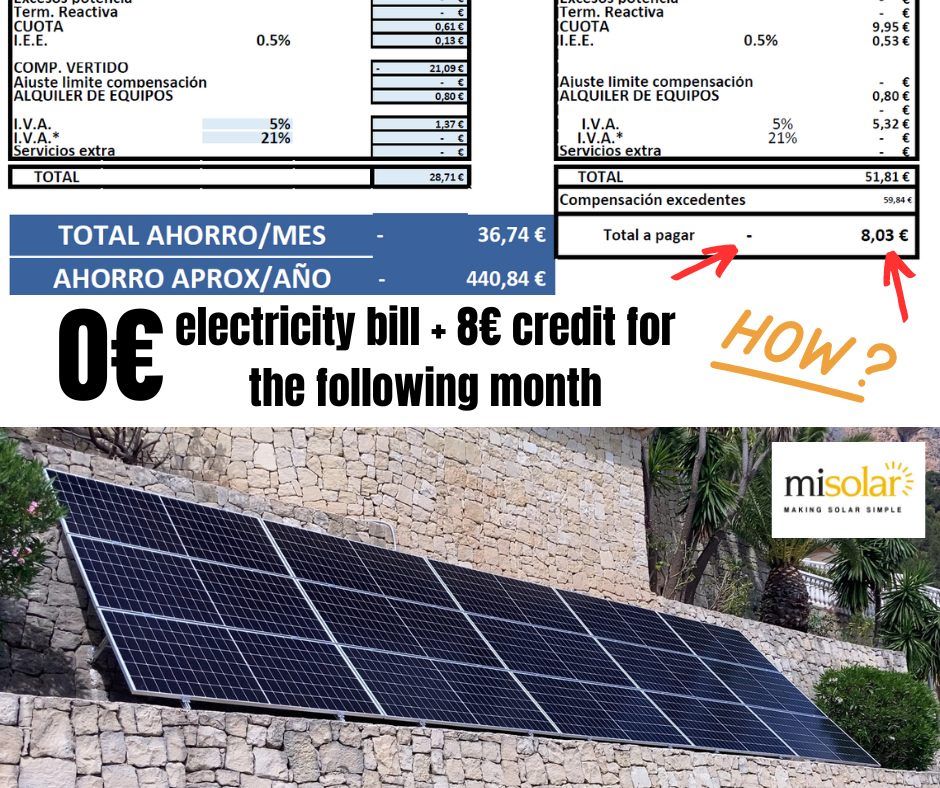
How popular is solar energy in Spain?
Are you surprised to hear that Spain is the most solar-powered nation on earth?
It’s true!
While China, USA, Japan, India, Germany and Australia all have more total installed photovoltaic capacity than Spain…
They also have much larger populations.
Spain has experienced an explosion in photovoltaic solar installations after the scrapping of the ‘sun tax’ in 2019 (more on this later) and in 2023 became the most solar-powered country in the world.
The theoretical PV penetration in Spain is now 19.1%.¹
Yes, that means roughly a fifth of Spain’s entire electricity generation should be coming from solar panels.
The majority of solar energy generation in Spain comes from large installations – during a period of sunshine in April 2023 these accounted for 52.1% of the entire national mix.²
But home solar energy installations have also sky-rocketed in popularity. By January 2023 more than 200,000 homes have a solar panel installation in Spain.
Aside from the sun tax and falling costs of solar panels, a third factor in the growth of home solar energy in Spain was the 2022 legal breakthrough that allowed homes to pay €0 to their electricity provider while remaining connected to the national grid.
At least 16,000 homes in Spain were subscribed to this new deal by the beginning of 2023.
The breakthrough is commonly called the ‘virtual battery’ – more on this later!
Is home solar energy renewable?
Spain’s national energy mix has a carbon footprint of 259g CO₂eq per kWh.³
The average detached home in Spain consumes 15,513 kWh each year which makes for a carbon footprint of 4 metric tonnes CO₂eq.⁴
Performance data from MiSolar clients shows that a minimum of 16 solar panels can produce over 15,513 kWh over the course of a year in Alicante, Spain.
So the average detached property in Alicante saves 4 metric tonnes of CO₂ each year with solar panels.
This is equivalent to:
- Driving 24,000km (15,000 miles) in a diesel car
- Four return flights for one passenger from Paris to New York
- The carbon capture of 150 trees in a year ⁵ ⁶
Solar panels are estimated to produce 50g of CO2 during manufacturing.⁷
It means the carbon footprint of manufacturing 16 solar panels is equivalent to the carbon footprint of 3 kWh in Spain – most detached homes here will consume 3 kWh by midday in a single day.
This makes a solar panel installation in Spain very eco-friendly.
While solar energy is renewable most solar panels come with a lifespan up to 25 years.
Currently the biggest environmental issue facing the home solar energy industry in Spain is how to recycle solar panels once they need to be replaced.
The first recycling plant in Europe is due to open in Teruel, Spain, this year with the capability of recycling up to 90% of the silicon, glass, aluminium and copper found in solar panels.⁸
We hope that more countries and regions will soon follow.

Do you pay tax on solar panels in Spain?
There are three kinds of taxes to consider when installing solar panels in Spain:
- Consumption taxes
- Installation taxes
- Value-added tax (or ‘IVA’ in Spanish)
1. Is there still a ‘sun tax’ in Spain?
The so-called sun tax was introduced on 9th October 2015 in Spain.
The law required producers of photovoltaic solar power to pay a tax on production and effectively ground the solar energy industry in Spain to a halt.
Home solar panel users were outraged.
The Spanish energy specialist Daniel Perez once said:
“It made no sense – imagine I have a vegetable patch and need to pay the supermarket every time I pick a tomato.” ⁹
The ‘sun tax’ was such a national scandal that Spain’s socialist government almost immediately repealed it on 5th October 2018 soon after coming to power.
Since 2018, the installed PV solar capacity in Spain has rocketed over 350%.
Thankfully the ‘sun tax’ is no longer an issue and if you install solar panels on your property in Spain there is no consumption tax you will have to pay.
(In actual fact the sun tax did not apply to any home solar energy system under 10kW, but the law created so much suspicion that few homeowners installed solar panels between 2015-2018 in Spain.)
2. Are there taxes to pay when installing solar panels in Spain?
In order to carry out renovations, installations or construction works on a private property in Spain you need to pay a tax to your local town hall.
This tax is called the Impuesto sobre Construcciones, Instalaciones y Obras (ICIO).
You need to pay this tax before carrying out a solar panel installation in order to obtain the relevant licence.
The tax is usually around 4% of the total installation – so for an installation of €7,000 you could pay up to €280.
But many towns throughout Spain have recently announced reductions up to 95% on the ICIO in order to incentivise property owners to go solar.
You will need to check individually with your town hall to see if legislation has been passed.
For example, we checked the legislation for 40 towns surrounding Javea in Alicante and found that Altea, Denia, Ondara and Teulada-Moraira had recently published announcements of a 95% reduction in the ICIO tax in the Boletín Oficial de la Provincia de Alicante.¹⁰
3. Do I pay VAT on a solar panel installation in Spain?
You need pay the Spanish VAT rate of 21% on any purchase of solar panels, solar inverters, solar batteries, and any other goods involved in an installation.
But there are two circumstances where the VAT rate can be reduced to 10%:
- Newbuild properties
- Properties undergoing a comprehensive renovation
To meet the requirements for the latter the project needs to include the rehabilitation of structural elements, facades, roofing and so on – also the total project cost needs to exceed 25% of the property’s purchase price.¹¹
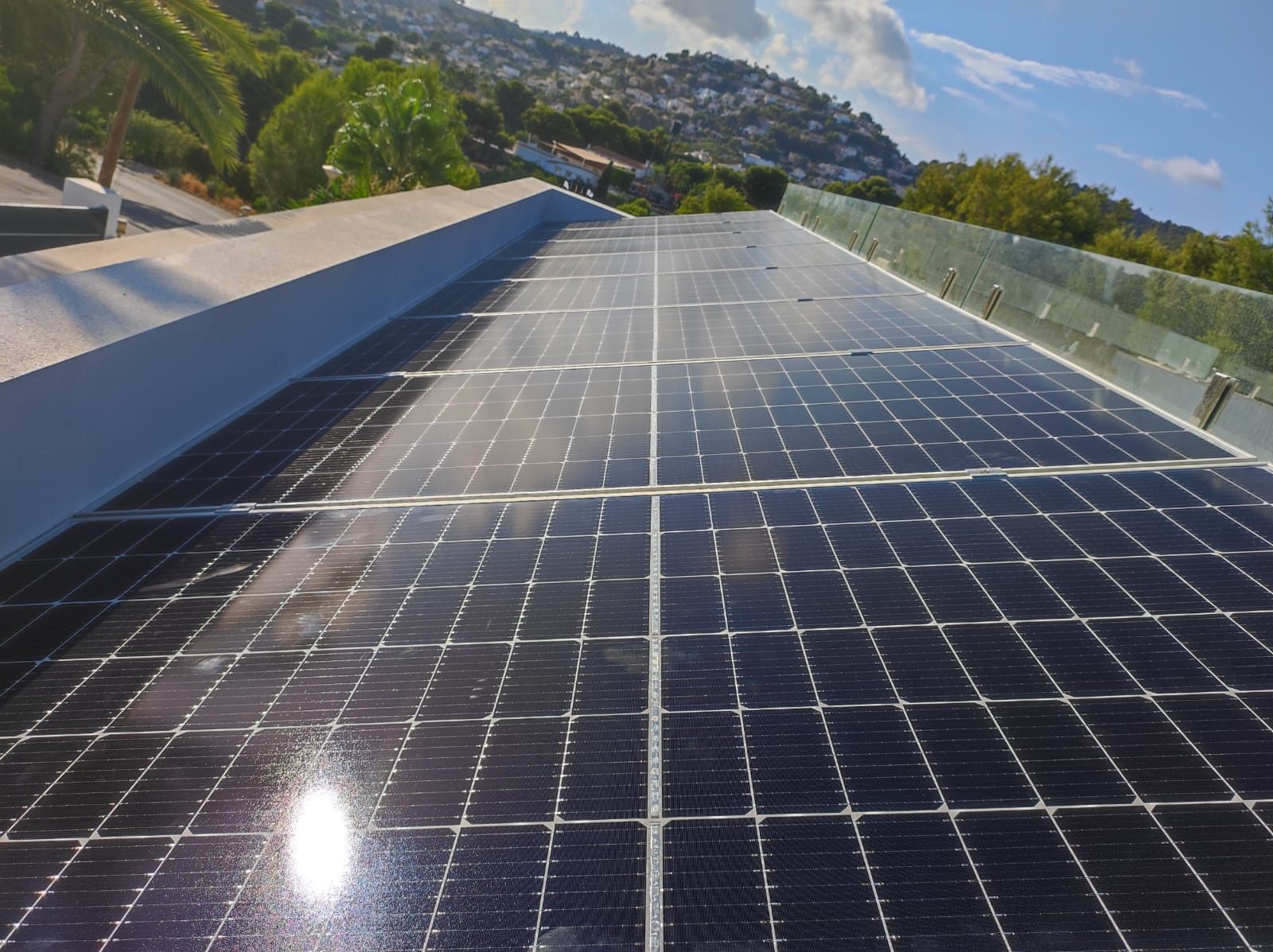
How do solar panels work?
There are two kinds of solar panel:
- Thermal solar panels
- Photovoltaic solar panels
Thermal solar panels absorb heat from the sun. Water is pumped through black tubing up to a solar collector usually on your roof and is heated directly by the sun.
Photovoltaic (PV) solar panels generate electricity from sunlight. When the sun shines onto a PV panel the radiation is absorbed by PV cells which generate an electrical charge.
A single PV cell can produce an open circuit voltage (VOC) around 0.46 volts and generate a power output around 1 watt.¹²
A single PV solar panel can contain as many as 144 individual PV cells to achieve an open circuit voltage up to 50 volts and a power output of 550W.
But how do PV solar panels power home appliances?
Solar panels produce direct current (DC) electricity. But when they are connected to a solar inverter, this turns DC electricity into alternating current (AC) which can power your home electrics.
AC electricity can also be fed into the national grid if it’s not consumed at home.
This requires a switch board to divert the flow of electricity and an energy metre to keep a record of AC electricity coming in from the grid and AC electricity flowing out to the grid (measured in kWh)

How many solar panels do I need to power a home in Spain?
A typical detached home in Spain has a contracted capacity of 4.6 kW agreed their electricity provider.
What does this mean?
It means the property can consume up to 4.6 kW of electricity at any one point – if consumption exceeds this limit then the power will go out.
This can serve as a rough guide for knowing how many solar panels you need.
If you have a contracted capacity of 4.6 kW the to fully replace your day-time electricity consumption with 550W solar panels you would need at least nine of them (550W x 9 = 4,950 W = 4.95 kW)
But in practice the number of solar panels you need depends on a number of factors.
Factors include:
- Average monthly electricity consumption
- Peak monthly electricity consumption
- Appliances used at home (e.g. air-conditioning, electric hot water cylinder, oven, etc.)
- Appliances that may be installed in future (e.g. heat pumps, electric car charger, pool pump, etc.)
- Average peak solar hours in your area
- Presence of solar battery or not
- Desire to export excess energy to the grid in return for reduced bills
- Many more factors
It’s common for homeowners to suddenly use more electricity after installing solar panels in Spain.
Why?
Because once you can cut your bills by 60-90% – or even down to €0 – you may want to run your home appliances for longer than you did before.
This is why it’s important to consult with a solar installer in your area before deciding how many solar panels you need.
Which solar panels are best?
There are 3 main types of solar panel:
- Monocystralline
- Polycrystalline
- Thin-film
Each type has its own pros and cons. If you’re looking to install solar panels in Spain on your own property then it quickly becomes clear which type is best suited to you.
See major differences in the table below.
| Solar Panel | Pros | Cons |
|---|---|---|
| Monocrystalline | Higher efficiency Higher performance | Higher cost Higher production in temperatures 25°C + |
| Polycrystalline | Lower cost | Lower efficiency Lower performance Lower production in temperatures 25°C + |
| Thin-film | Portable and flexible Lower installation costs | Lower efficiency Lower performance |
Monocrystalline solar panels are 15-22% efficient and this is currently the best performance you can find on the market. Solar cells are made from a single silicon crystal and this comes with added manufacturing costs. The average monocrystalline solar panel costs €200-300 in Spain – and this is roughly the savings in electricity costs one solar panel can give you in just the first year of production.
Polycrystalline solar panels are 15-17% efficient. Solar cells are produced from silicon fragments rather than a single, pure silicon crystal. Production of polycrystalline panels largely halted in 2020-2021 as most of the major manufacturers solely produce monocrystalline panels due to differences in efficiency and performance.
Thin-film solar panels are typically 11% efficient. They can be made from a variety of materials such as cadmium telluride (CdTe), amorphous silicion (a-Si) or copper indium gallium selenide (CIGS).¹³ The majority of homeowners install monocrystalline solar panels to save space and increase performance, but if your roof cannot handle the weight of traditional solar equipment you may need to consider thin-film solar panels. Thin-film is also a portable and flexible solution for RVs and boats, for example.
How much electricity can 1 solar panel produce?
In Spain your electricity provider will charge you based on the number of kilowatt-hours (kWh) you consumed in the past month.
This refers to the number of hours your property consumed 1 kW from the national grid.
The amount of kWh a single solar panel can produce depends on three main factors:
- Number of solar cells in a single solar panel
- Efficiency of the solar panel
- Number of peak solar hours in your region
Each solar panel will come with a power output or power rating expressed in Watts. The majority of monocrystalline solar panels have a power rating between 300W to 550W.
With the power rating you can calculate how many kWh a single solar panel will produce.
The simple calculation might look like this:
Kilowatt-hours (kWh) = (peak solar hours x power rating)/1,000
As an example, the average number peak solar hours in Javea in Alicante is 5,7 per day. Let’s say we are installing monocrystalline solar panels with a power rating of 550W.
Kilowatt-hours (kWh) = (5.7 x 550 watts)/1,000 = 3.135 kWh
You could then multiply this figure by 365 to get a rough idea of how much electricity this single solar panel can produce in a whole year.
Kilowatt-hours (kWh) = ((5.7 x 550 watts)/1,000) x 365 = 1,144 kWh
The average cost of electricity in 2022 was 0.21 €/kWh meaning that a single 550W monocrystalline panel could produce the equivalent of €240 of energy in its first year.
This is almost exactly the unit price of a 550W monocrystalline solar panel in Spain. After year 1, you would have broken even and be receiving ‘free’ electricity for the next 24 years of the solar panel’s lifespan.
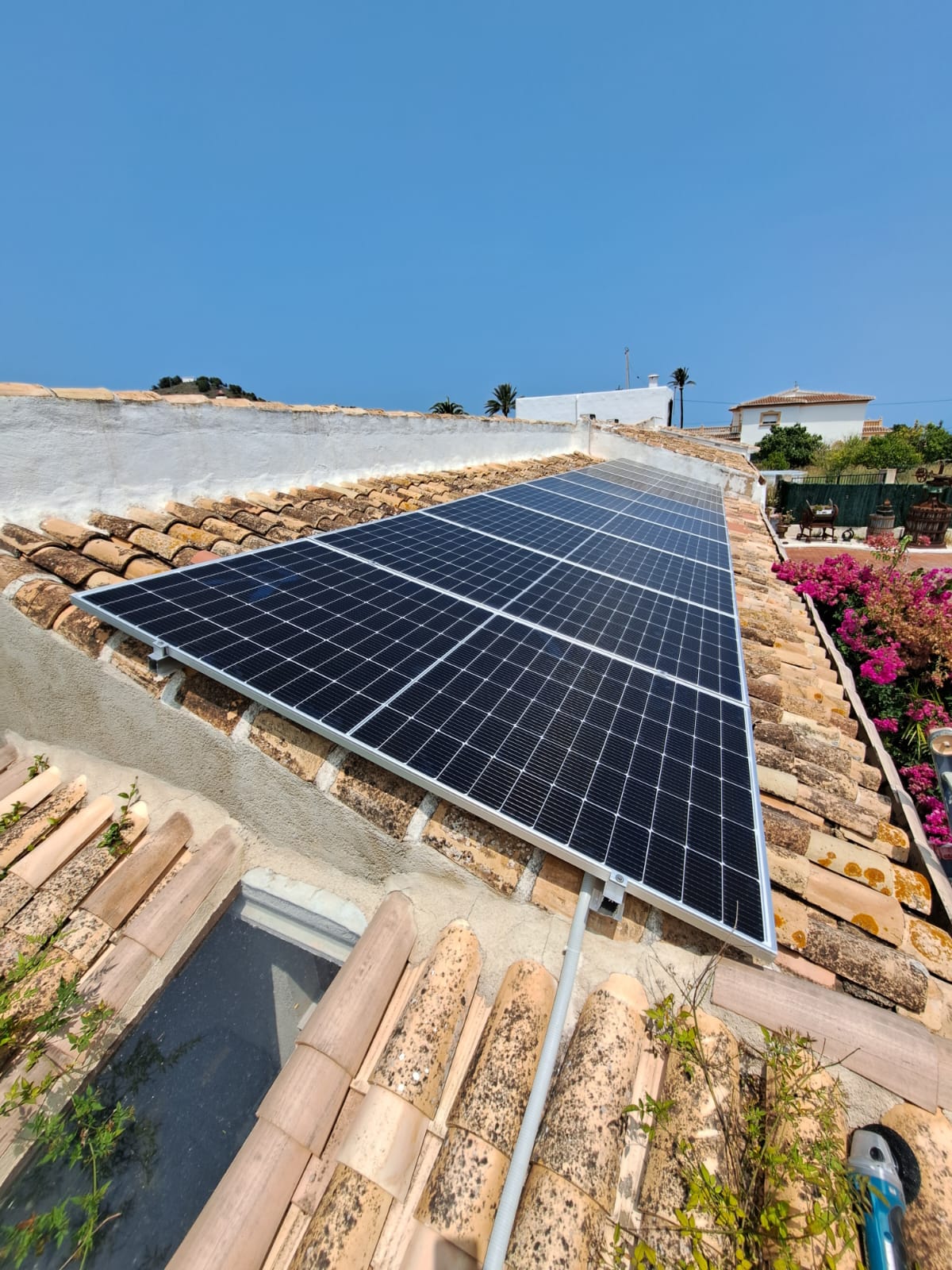
How much maintenance do solar panels need?
Research has shown that dirty solar panels can lose as much as 20-50% of their normal production.¹⁴
This is why it’s recommended to clean your solar panels following a storm or long period without rainfall.
In Javea in Alicante, for example, the pine blossom in spring and sporadic rain showers leaving red-brown dirt can reduce the performance of solar panels if left uncleaned.
It is natural for solar panels to decrease in performance over time.
You can monitor the overall production of your solar panel system directly via an app connected to your solar inverter and contact your installer for any questions or for a routine check-up.
Note – many homes in Spain use a sub-contracted installer where there is no promise of warranties and no promise of help should you have any questions.
This is why MiSolar concentrates our installations to a small area surrounding Javea and offers a 10-year warranty on your solar panels.
Do I need to install a solar battery?
A solar battery can add €1,000s onto the cost of a solar panel installation in Spain.
Are they necessary?
Unless your property is completely off-grid or you’re installing high-power appliances like an electric car charger, we don’t always recommend you install a solar battery.
This is because a solar battery can increase your break even date by years and with the virtual battery (more on this later) they are no longer required to get your bills down to €0 per month.
If your property is already connected to mains electricity it may be wiser to install solar panels now and then wait for the price of solar batteries to fall in the coming years.
Below find out about the 5 main types of solar battery used in solar panel installations in Spain.
| Solar battery | Pros | Cons |
|---|---|---|
| Sealed lead-acid | Lower costs (€150-€1,200) High power output capability Quick re-charging | Shorter lifespan (3-5 years) Sensitive to overcharging Sensitive to deep-discharging (ideally not below 50%) Heavy |
| Flooded lead-acid | Lower costs (€200-600) High power output capability | High maintenance Release hydrogen into surrounding space Must be kept upright Sensitive to deep-discharging (ideally not below 50%) |
| Lithium-ion | Less maintenance Longer lifespan (15-20 years) More lightweight Higher depth of discharge up to 80% and more Higher efficiency | Higher costs (€1,000-€15,000) Sensitive to overheating if not properly installed |
| Flow batteries | Higher depth of discharge up to 100% Non-toxic (water based) Longer lifespan (up to 30 years) | Low storage capacity New technology Not easy to find on the market |
| Nickel cadmium | Can operate at high temperatures Longer lifespan (20+ years) Higher depth of discharge up to 80% Best for large-scale industrial installations | Toxic and banned in many countries Old technology Not recommended for small-scale home installations |
For home solar panel installations in Spain, lithium-ion and lead-acid are the most common solar batteries.
The right choice for you depends on a number of factors.
Let’s take a look at some of the terminology seen above and other considerations.
How to know the right size solar battery for me?
A solar battery’s size is measured in kWh. For example a battery could be 2kWh or 20kWh and over. It’s important to work out how many kWh you may need to consume at night or in lowlight conditions when your solar panel production before choosing the right solar battery for you. For example, if you need 0.75-1kW of power then a 10kWh battery could last 10-12 hours and a 13 kWh could last 13-16 before it needs to be recharged.
How to know the right power rating of a solar battery for me?
A solar battery’s capacity is measured in kW. For example a solar battery usually has a continuous power output around 5kW.
How to know what efficiency I need in my solar battery?
A solar battery’s efficiency refers to the percentage of electricity put into storage that can be used later. Typically the efficiency of a solar battery is around 80%.
What does the depth of discharge mean in a solar battery?
Depth of discharge (DoD) refers to the amount of energy you can use out of your solar battery. For example, let’s say your battery size is 8kWh with a DoD of 80%. That means you can use a maximum of 6.4 kWh before you need to recharge the battery. As you can see in the table above, it’s not recommended to use more than 50% of the energy in a lead-acid battery. But a lithium-ion battery, flow battery or nickel-cadmium battery can be discharged up to 80% and more.
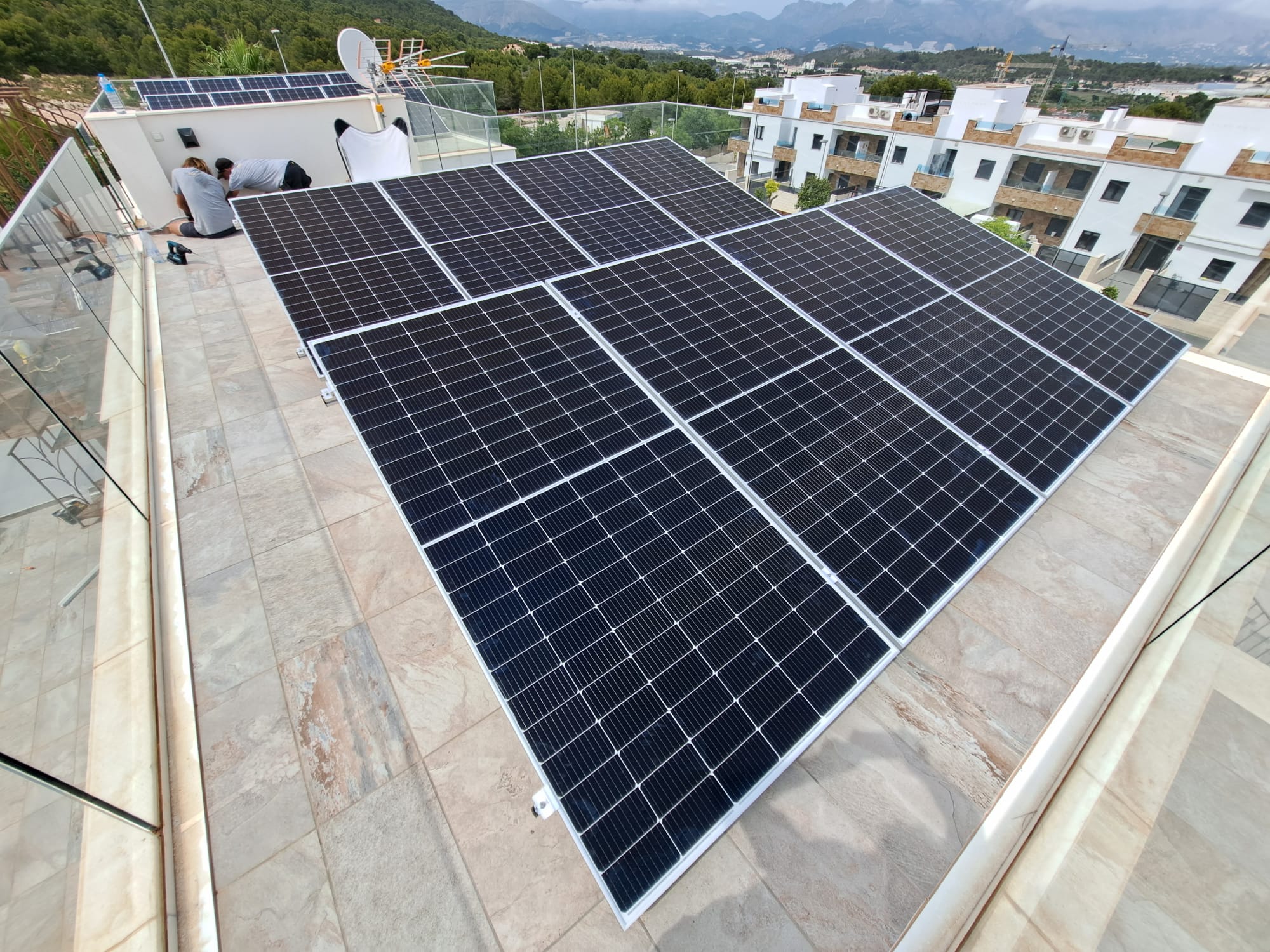
Are there feed-in tariffs for solar panels in Spain?
Feed-in tariffs entered the Spanish market on 5th April 2019.
For the first time, home solar panel users could receive credit for excess kWh exported to the national grid. This credit is discounted from your electricity bill at the end of each month.
The most imported figures in a feed-in tariff with your supplier are:
- The price you pay for energy from the grid (in 2022 this reached a high of €0.21 per kWh)
- The price you are ‘paid’ for energy given to the grid (between €0.05 – €0.18 per kWh)
You can choose a fixed compensation rate or an indexed rate that moves with the market.
There are more than 28 feed-in tariffs available with a variety of different energy companies in Spain. When we looked at them in early 2023, the difference in your monthly bills is staggering.¹⁵
A property with a 4.6 kWh system (and no solar battery) could have paid €505 every year for electricity from one provider and €0 from another provider.
But even if you secure a feed-in tariff with the best rates of compensation, you will never actually get your monthly electricity bills to €0 in Spain. This is because suppliers include fixed standing charges, costs and taxes into the bill which can range between €15-50 per month.
So how could a few providers offer €0 electricity bills as we stated above?
This is thanks to a feed-in tariff that also comes with a ‘virtual battery’.
Read on to find out more.
What’s the virtual battery in Spain?
In April 2022 the Spanish renewable energy campaigner Jorge Morales de Labra began a fight to change the law on solar self-consumption in Spain.¹⁶
He complained that fixed standing charges were slowing down Spain’s transition to greener energy.
The campaign was successful. A new legal precedent was set. And and by January 2023 at least 16,000 homes in Spain were subscribed to feed-in tariffs that included a ‘virtual battery’.
What actually is a virtual battery?
Here are the three most important features:
- Excess energy saved in a ‘virtual battery’. Before the virtual battery the kWh you gave to the grid would be discounted down to the standing charge in your bill, and then any extra kWh would effectively be given to the grid for free. With a virtual battery any extra kWh you give to the grid can now accumulate as credit and be saved in your account for up to 12 months – and sometimes more.
- A better rate. Virtual battery suppliers tend to compensate the kWh you sell to the grid at a better rate than with a feed-in tariff.
- No standing charges. Before the virtual battery you could only discount your monthly bill down to a fixed standing charge of €15-50. Now it is possible to discount your monthly bill down to €0. Some virtual battery providers will charge a fixed monthly subscription of €2-5 separate to your bill – but others will genuinely let you pay €0.
Virtual batteries are game-changing.
They mean you can slightly oversize your solar installation in order to get your bills to €0 each month. You can even oversize your system to accumulate credit during certain times of the year and use this to pay off your bills at other times of the year.
For example, if you only live in Spain for part of the year you can now accumulate credit when you’re not at home and use this to offset any grid consumption when you are at home.
If you live here full-time, you could accumulate credit during the summer months when production is high and use this offset any grid consumption during winter when production is lower.
Crucially the virtual battery means you no longer need to invest in a solar battery to get your bills to €0.
MiSolar has partnerships with some of the leading virtual battery providers in Spain.
If you install with us, we can size your system correctly and then set you up on one of these deals so you start to get your bills close €0 within 1-5 weeks after an installation.
Do you need planning permission to install solar panels in Spain?
In general, you need to secure planning permission before installing solar panels on your property in Spain.
In Spain this permission is called the licencia de obras.
During the application process to your town hall you will also need to pay a tax called the Impuesto sobre Construcciones, Instalaciones, y Obras (or the ICIO) which can be 4% of the total installation cost.
However, a number of autonomous communities have scrapped the need for planning permission altogether.
If you live in these areas in Spain you will not need planning permission at all:
- Andalucía
- Baleares
- Cataluña
- Extremadura
If you live in other areas of Spain like the Valencian Community (including Alicante) a number of towns have recently introduced a 95% reduction in the ICIO tax.
We looked at 41 towns in the region surrounding Javea where we install solar panels.
If you live in one the towns below then you will still need to apply for planning permission but you will receive a 95% reduction in the tax itself:
- Alcalalí
- Altea
- Benitachell
- Denia
- Els Poblets
- Javea
- Jalon
- Ondara
- Parcent
- Teulada-Moraira
How long until I break even on a solar panel installation?
The majority of MiSolar clients are set to break even within 3-5 years.
How can we be so sure?
During the quote process we enter estimated production details into a calculator and provide a break even estimation.
The break even estimation accounts for:
- Current energy prices – the average price of electricity in Spain in 2022 was €0.21
- Inflation – the price of electricity has risen 1.9% each year in the past decade, but with added costs and taxes the total inflation can be as high as 6%
- Solar hours – the average peak solar hours in the client’s region
- Solar production – the maximum production of your solar panels will fall slightly each year
- Accumulated cashflow – We add up the savings realised each year to estimate the break even
instant calculation!
How Quickly Could You Break Even on a Solar Installation with €0 Electric Bills?
We’ve created an online calculator that generates an instant annual return and break even estimation with a €0 bill, fully optimised system and current package of solar incentives in Spain factored in.
Click below to get a result in the next 2-3 minutes.
Can you get grants for solar panels in Spain?
Homeowners in Spain can no longer access to the €1.3 billion in EU funding to incentivise the installations of solar panels, solar batteries and aerothermal units.¹⁷
The current phase of funding ended on December 31st 2023.
Spain has asked for an extension of funding to continue offering the solar grant until 2026 – but as of early 2024 there has been no update.
In case grants comes back online, here’s a table of what was on offer.
| Programme | Beneficiaries | Installation | Grant | Deadline |
|---|---|---|---|---|
| Nº 1 | Service businesses | Solar panels | Up to 45% | 31/12/2023 |
| Nº 2 | Other businesses | Solar panels | Up to 45% | 31/12/2023 |
| Nº 3 | Businesses (with an installation) | Solar batteries | Up to 65% | 31/12/2023 |
| Nº 4 | Homeowners | Solar panels | Up to 600 €/kWp | 31/12/2023 |
| Nº 5 | Homeowners (with an installation) | Solar batteries | Up to 450 €/kWp | 31/12/2023 |
| Nº 6 | Homeowners | Thermal solar panels/ aerothermal | Up to 900 €/kWp | 31/12/2023 |
If you own a home in Spain and want to install solar panels then programmes 4-6 are the ones to look at.
Under programme 4 in particular you could receive up 600 €/kWp.
What does kWp mean?
KWp refers to the kilowatt ‘peak’ power output of your solar installation.
For example, say you install 10 solar panels each with a maximum output of 500W then you would have a 5 kW system (10 x 0.5 kW) and a kWp of 5.
If you install solar panels in Spain and apply for EU funding before 31st December 2023 you can receive €3,000 in grants.
But note that the grant of 600 €/kWp is also only available for solar panel installations in Spain with a kWp under 10. If you’re system is over 10 kWp then you can get between 350-450 €/kWp depending on the region where you live in Spain.
You can see a list below of the €/kWp in grants currently available in the 17 autonomous communities in Spain.
| Autonomous Community | €/kWp for < 10kWp | €/kWp for 10kWp-100kWp |
|---|---|---|
| Andalucía | 600 €/kWp | 450 €/kWp |
| Aragón | 600 €/kWp | 450 €/kWp |
| Asturias | 600 €/kWp | 450 €/kWp |
| Canarias | 600 €/kWp | 350 €/kWp |
| Cantabria | 600 €/kWp | 450 €/kWp |
| Castilla–La Mancha | 600 €/kWp | 450 €/kWp |
| Castilla y León | 600 €/kWp | 350 €/kWp |
| Cataluña | 600 €/kWp | 450 €/kWp |
| Comunidad Valenciana | 600 €/kWp | 450 €/kWp |
| Extremadura | 600 €/kWp | 450 €/kWp |
| Galicia | 600 €/kWp | 450 €/kWp |
| Islas Baleares | 600 €/kWp | 450 €/kWp |
| La Rioja | 600 €/kWp | 450 €/kWp |
| Madrid | 600 €/kWp | 450 €/kWp |
| Murcia | 600 €/kWp | 450 €/kWp |
| Navarra | 600 €/kWp | 450 €/kWp |
| País Vasco | 600 €/kWp | 450 €/kWp |
What about the grant for a solar battery?
Your solar battery will be only considered valid for a grant if your property is off-grid.
How long does it take to receive the grant money?
There are four stages to the grant application and payout.
Official rules state you should receive a ‘resolution’ or preliminary approval within 6 months. However, the current EU-funded solar grants in Spain are so popular that application channels have a backlog.
In many cases it can take over 12 months before you receive the solar grants.
Note that you will be required to pay for the solar panel installation upfront before you can submit the relevant documents needed to apply for the grant.
What are the requirements to get the solar grant?
For this round of EU funding you needed to apply before 31st December 2023.
If you already have a solar panel installation on your property in Spain it’s likely too late to apply for a solar grant.
Why?
Because among the application documents you need are official energy efficiency certificates carried out by a certified professional from both before and after the installation. If you don’t have an energy efficiency certificate from prior to the installation, then you cannot get one retrospectively.
You also need to submit the original itemised quote as part of the application. If you made the installation yourself then you may not have the required documents to be eligible for a solar grant in Spain.
Here’s a list of other requirements to consider:
- Only a certified electrician can create an energy efficiency certificate in Spain
- Only a certified electrician can legalise your installation with your town hall and the authorities
- If you have other grant applications pending payment then a second application may be refused
- If you have any debts with Hacienda or Seguridad Social then your application may be refused
- Your solar installation needs to include a monitoring system (except for programme Nº 6)
- You need to show or prove that you consume at least 80% of the kWp installed on your property
- You will need to provide the installation quote along with your application
- You can only receive a reduction in your tax return for materials, equipment, labour, monitoring and control systems, removal of previous electrical systems, proposal writing, management costs – you cannot receive a reduction in your tax return for IVA (VAT), personal expenses, environmental studies, any costs for loans or fines, insurance or surveillance costs
The solar grant application can be complex and if you make a mistake then it’s likely you will receive a notification of the errors months later, and so the entire grant approval process will be delayed.
Can you still get a tax rebate for a solar installation in Spain in 2024?
Yes.
In fact, few of our clients have already received their grant payment – even though we completed their installations in 2022!
But these same clients have already received a tax rebate in the first annual tax declaration after going solar.
In the Valencian region, there is a tax rebate available of 40% of total installation costs up to €8,000.
This means you could receive up to €3,200 back as a tax rebate.
Of course, you will need to be a tax resident in Spain and you will need to already have income tax (IRPF) to pay in order to fully benefit from the rebate.
For more information on solar tax rebates currently available in 2024 please read our blog on solar incentives in Spain here.
What other solar incentives are available?
You can also access a reduction in your annual property tax (IBI) payments.
The reduction is typically between 10-50% for between 1-5 years starting the first year after you install solar panels on your property.
The exact reduction depends on the municipality where you live.
For example.
In some towns near Javea (where MiSolar is based) there’s a maximum reduction of €200 per year for 3 years. In others there’s a 50% reduction with no limit for 3 years. In others there’s a 25% reduction for up to 6 years.
So how much could you save on IBI payments in your town?
We created a list of the tax reductions available in the 41 towns where MiSolar installs solar panels in the region surrounding Javea.
These are towns such as Denia, Teulada-Moraira, Benissa, Calpe, Benidorm, Altea, Pego, Oliva and more.
You can see the IBI reductions currently available by filling out our Break Even Calculator.
solar break even calculator
How Quickly Could You Break Even on a Solar Installation with Tax Rebates & Property Tax Reductions Factored in?
Solar incentives make it possible to break even on a solar installation in as little as 3-5 years.
After breaking even, our clients are on track to save over €5,000 and even over €10,000 in the next 10 years alone.
You can now use the same Solar Break Even Calculator we use to prepare estimations for our clients.
Use it find out how much you could receive in tax rebates and property tax (IBI) reductions in Spain.
Click below to get a result in the next 2-3 minutes.
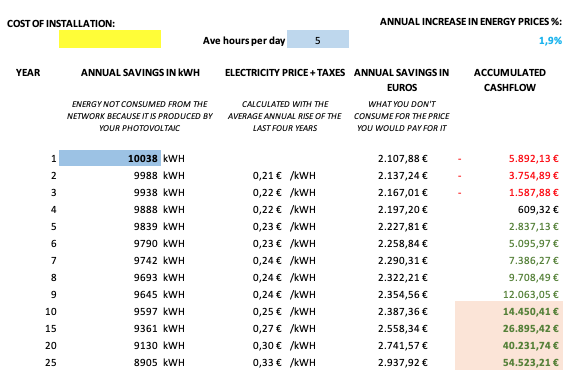
Footnotes
- https://www.pv-magazine.es/2023/04/24/espana-es-el-pais-con-mayor-penetracion-fotovoltaica-del-mundo-y-lider-en-potencia-instalada-en-europa-en-2022/
- https://www.pv-magazine.es/2023/05/15/espana-registra-nuevo-maximo-de-generacion-fotovoltaica-mensual-en-abril/
- https://canviclimatic.gencat.cat/es/actua/factors_demissio_associats_a_lenergia/
- https://www.ocu.org/vivienda-y-energia/gas-luz/noticias/cuanta-energia-consume-una-casa-571584
- https://www.climateneutralgroup.com/en/news/what-exactly-is-1-tonne-of-co2/
- https://www.crownoil.co.uk/news/1-tonne-of-co2-what-does-it-look-like/
- https://solarisrenewables.com/blog/carbon-footprint-of-solar-panel-manufacturing/
- https://www.residuosprofesional.com/teruel-planta-reciclaje-paneles-solares/
- https://www.newtral.es/impuesto-al-sol/20220915/
- https://misolar.website/solar-panels-spain-grants-subsidies-tax-breaks/
- https://www.cambioenergetico.com/blog/iva-reducido-autoconsumo-paneles-solares/
- https://www.alternative-energy-tutorials.com/photovoltaics/photovoltaic-panel.html
- https://news.energysage.com/types-of-solar-panels/
- https://www.solar-panel-cleaners.com/why-clean-solar-panels/
- https://www.ocu.org/vivienda-y-energia/gas-luz/informe/tarifas-compensacion-excedentes

